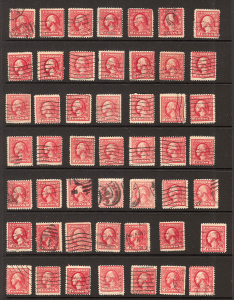I guess you don’t have to be autistic to collect stamps (or coins, or bills, or anything else), but I’m sure it helps.
For many years (and long before I figured out that I’m autistic), I collected stamps. More than collected, I accumulated.
In the past few years, I’ve been gradually selling off my accumulation of philatelic material on eBay. It’s been fun. What remains is not of much value, but I am still enjoying this aspect of the hobby — I think of it as reverse collecting, and I get to enjoy looking at my stamps all over again as they go out the door.
I’ve recently come across an accumulation of glassine envelopes all marked “528B” containing a bunch of carmine *2 CENTS 2* stamps that were issued in 1920, a few of which are illustrated in this picture. (Click on the graphic to see an enlarged version so that you, too, can be fascinated with the details!)
I bought these in the hope of being able to go through them to find varieties worth more than the one I nominally paid for. There are literally 43 varieties of stamps that look exactly like this. What distinguishes them from each other are several different features of their printing and post-printing production. Without getting into all of the detail, I could mention such things as paper (whether it is watermarked or not), type of printing press (flat plate, rotary, or offset), perforation (number of perforations — if any — within 2 centimeters), released as sheets or coils, and certain engraving varieties. And of top of all that there are many, many printing errors which are collectible, such as double impressions or plate defects that are easily spotted. There are also color variations, sometimes several within each variety.
The reason I still have all of these is that I never fulfilled my ambition of closely examining them. I found that looking at each one under a magnifying glass was too tedious (even for me), and often yielded ambiguous results. So I set them aside for a future project. Well, the future is now! Through the modern miracle of digital scanning, I am able to scan these (at much greater resolution than is shown here) and determine (with some exceptions) which variety they represent. The exceptions include stamps where the cancellation obliterates distinguishing features, in which case I have to assume that the stamp is the less valuable of two or more possible varieties.
The stamps illustrated here represent but 5 of those 43 varieties. They are all offset printings, perforated 11 on both top and sides, and can be distinguished from each other by “Type” of engraving.
- 526 type IV has a broken line at the top of the toga and the toga button looks like the letters DID, with the first D reversed
- 527 type V has a complete toga line (as do all the other varieties here), and 5 vertical line in the toga button, with a thin/broken line in the left “2”
- 528 type Va is the same as type V except that there are two dots missing in one of the lines of dots in the nose
- 528A type VI is the same as V but has a very heavy line in the left “2”
- 528B type VII is pretty much the same as V but the line in the 2 is between V and VI in thickness, and an additional row of dots has been added to the upper lip
The numbers are from the Scott catalog, which is pretty much the Bible of stamp collecting. Plate types I, II, and III were used in earlier printings of flat plate and rotary press designs.
These are not valuable stamps. The Scott catalog lists their retail prices (which assumes stamps in good condition, which many of these are obviously not) as ranging from 40¢ to $4.00. I feel lucky if I am able to sell a stamp for 20% of its Scott value. So, their worth to me is somewhere between 8¢ and 80¢. I have not discovered a gold mine. Still, it’s fun for me to go through them. And to blog about them.
On this particular page (which does not represent my entire accumulation by any means!), I found that only 11 out of the 49 here are actually the 528B stamps I paid for. I did not find any of the most valuable (526) but the other varieties are all well-represented.
How I will manage to sell all of these on eBay, I have no idea. But I’m on a mission!

